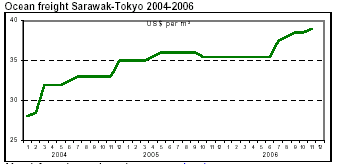|
Japan
Wood Products Prices
Dollar
Exchange Rates of 30th November 2006
Japan
Yen 115.63
Reports
From Japan
Plywood prices to peak as winter season approaches
Prices for Southeast Asian panel seemed to be peaking in late November. According to some Japanese traders, some
Indonesian and Malaysian suppliers’ were asking prices below last price levels. Demand was slowing due to the
approaching winter season. In northern Japan, building activities were slowing down due to the first snowfalls.
In Osaka, the demand for panels remained strong. Plywood manufacturer Seihoku had been shipping
softwood panels to the Osaka market, but inadequate supply has forced Osaka dealers to look for substituting
materials such as OSB and particleboard. Prices for domestic softwood plywood prices were still more than
30% lower than those for Southeast Asian panels. Seihoku, Japan’s major softwood panel maker, has raised the prices ten times since early this year.
China takes the lion share of Japan’s furniture imports
Japan’s furniture imports totaled ¥240.64 billion during the first half of 2006, up 111% from last year, according to
the Ministry of Finance. Wood furniture accounted for 46% of the imports while metallic, rattan and other
material furniture accounted for 20%, 1% and 2%, respectively. Imports of furniture parts accounted for the
balance (31%). Imports of all these categories rose in the period, except rattan furniture.

Japan imported almost 87% of the wooden furniture from
Asia in the period under review. China (46%), Thailand (12%) and Vietnam (10%) were the largest suppliers.
Imports from Europe accounted for 12% of the imports, notably from Italy (38% of the imports from Europe),
Germany (16%) and Denmark (12%). With regards to rattan furniture, 89% of the imports came from Indonesia.
With respect to the imports of furniture parts, China was the largest supplier (40%), followed by Mexico (15%), the USA, Australia, Germany, Taiwan PoC and Thailand.
Nippon Oil to develop biofuel from Malaysian palm oil
Nippon Oil Corp. and Toyota Motor Corp. will jointly develop a new diesel fuel made from palm oil, in
conjunction with the Malaysian state-run petroleum company Petronas. The three companies will start joint
research in 2007 and begin test production in Malaysia in 2009. It would be the first major attempt in the world to
convert palm oil into automotive fuel, according to the companies. Palm oil is extracted from coconuts and
commonly used in margarine and pastry production. Nippon Oil is looking to gain the upper hand in the biofuel
market by collaborating with Malaysia, the world’s largest palm oil producer.
The move comes as Japan, the world’s third largest oil consumer, prepared to set up nationwide biodiesel
standards in an effort to diminish dependency on crude oil and help ease global warming. If palm oil gains
widespread acceptance in Japan as an alternative to petroleum, it would increase demand for this product from
Southeast Asian. The project started to take shape after the Malaysian Prime Minister Abdullah Ahmad Badawi asked
Japan in May 2006 to collaborate with his country in exploring biofuel technology.


|
|
Abbreviations
| LM
Loyale Merchant, a grade of log parcel |
Cu.m
Cubic Metre |
| QS
Qualite Superieure |
Koku
0.278 Cu.m or 120BF |
| CI
Choix Industriel
|
FFR
French Franc |
| CE
Choix Economique
|
SQ
Sawmill Quality |
| CS
Choix Supplimentaire |
SSQ
Select Sawmill Quality |
| FOB
Free-on-Board |
FAS
Sawnwood Grade First and |
| KD
Kiln Dry |
Second |
| AD
Air Dry
|
WBP
Water and Boil Proof |
| Boule
A Log Sawn Through and Through |
MR
Moisture Resistant |
|
the boards from one log are bundled |
pc
per piece |
|
together |
ea
each |
| BB/CC
Plywood grades. Letter(s) on the left indicate
face veneer(s), those on the right backing veneer(s). Veneer grade
decreases in order B, BB, C, CC, etc. |
MBF
1000 Board Feet
|
|
Plywood |
MDF
Medium Density Fibreboard |
| BF
Board Foot |
F.CFA CFA Franc
|
| Sq.Ft
Square Foot |
PHND
Pin hole no defect grade |
| Hoppus ton 1.8 cubic
metres |
  Price has moved up or down
Price has moved up or down |
|
|
|